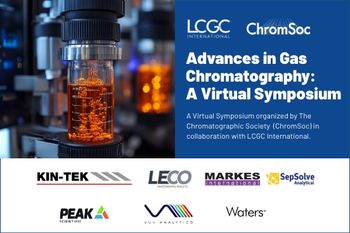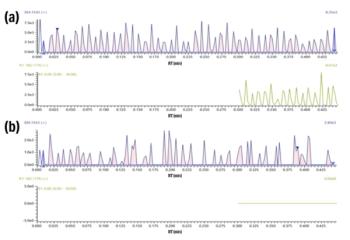
Environmental Forensics in the Workplace
Populations worldwide are exposed to polychlorinated biphenyls (PCBs) that can be harmful to human health. LCGC spoke to David Megson from Ryerson University in Toronto, Canada, about recent developments in assessing human exposure to PCBs and chiral enantiomer fractions (EFs) in the workplace.
Populations worldwide are exposed to polychlorinated biphenyls (PCBs) that can be harmful to human health. LCGC spoke to David Megson from Ryerson University in Toronto, Canada, about recent developments in assessing human exposure to PCBs and chiral enantiomer fractions (EFs) in the workplace.
Q. Your team investigated polychlorinated biphenyl (PCB) signatures and chiral enantiomer fractions (EFs) of CB-95, CB-136, and CB-149 in 30 workers at a transformer dismantling plant.1 How did this project come about?
A: Originally the project started as an environmental forensics investigation that formed part of my PhD at Plymouth University, UK. I was fortunate enough to be able to collaborate with Don Patterson (Exponent Inc, Georgia, USA) and Jef Focant (University of Liège, Belgium) to see if it was possible to age-date human exposure to polychlorinated biphenyl (PCBs). I was able to continue the project with the help of Mathew Robson and Eric Reiner at the Ontario Ministry of the Environment and Climate Change where we looked at chiral PCBs. PCBs are one of the most commonly encountered groups of organic contaminants in the environment and we are all exposed to them in our daily lives. However, there have been many unfortunate events throughout history where people have been exposed to elevated concentrations of PCBs. In these cases it is important to be able to establish who was responsible so those affected can seek justice. This can require a potential source of PCBs to be distinguished from background exposure. Being able to help people answer questions like these greatly motivated me to undertake the research.
Q. By what routes are PCBs entering the environment?
A: PCBs were first commercially produced in 1929 and were manufactured until the 1970s and 1980s when their use was phased out as a result of environmental and human health risks. However, because of their widespread use they are found all over the globe. The majority of the average person’s exposure arises from food; however, PCBs were also used in caulking and sealant materials in older buildings, and inhalation can also be a significant source. One of the major uses of PCBs was as dielectric fluids in electrical transformers; as the transformers reach the end of their lifecycle the PCBs need to be removed and disposed of safely. Our investigations focused on a small subset of the population who were responsible for dismantling these transformers and were therefore potentially in contact with high amounts of PCBs.1
Q. Can you tell us more about the “chiral enantiomer fractions” investigated in this study?
A: We selected three chiral PCBs (CB-95, CB-136, and CB-149), as these were the enantiomers that were present in the highest concentrations in the samples. We undertook the analysis using a high-resolution mass spectrometer (HRMS) with a chiral column, however we are looking to develop a comprehensive gas chromatography (GCXGC) method in the near future. The results of this investigation were really exciting. Commercial PCB mixtures are racemic, that is, they have the same proportion of E1 and E2 enantiomers and so have a ratio of 0.5. However, in some serum samples the ratio was greater than 0.9 indicating the near complete removal of the E2 enantiomer. Shifts on this scale are very unusual and we had to check the data several times and rub our eyes to believe it. I consider this to be the strongest evidence to date that enantiomer specific metabolism of PCBs occurs in humans.
Q. What does it mean to age-date exposure and why is this measurement important?
A. Being able to age-date an exposure event can be an incredibly important factor in an environmental forensics investigation. Take the following scenario as an example: A worker has been dismantling transformers containing PCBs for the last 5 years. However, prior to that he was living and working next to a historic landfill site where the owners were known to have been previously accepting PCB waste illegally. The worker gets ill and the cause is believed to be due to PCB exposure. In this case there are two major potential sources of exposure from different time periods. Being able to undertake source identification and age date exposure provides complementary lines of evidence, which can help to uncover the truth, and prosecute those responsible.
Q. You decided to use comprehensive gas chromatography (GCXGC) for this project.1 Why did you decide on this analytical approach?
A: In my opinion too many investigations only focus on a small set of PCBs, such as the seven indicator PCBs or the WHO12 dioxin-like PCB. Whilst these are useful for initial screening or to establish human health risks, they are not great when looking at more complex forensics questions such as age dating or source apportionment. We conducted a literature review and used the National Health and Nutrition Examination Survey (NHANES) database2 to identify which PCBs were easily bio-transformed and eliminated in humans and which congeners were accumulated. This identified that PCBs with chlorine bonding in the 2,5- and 2,3,6- positions (and 2- in di- and tri-chlorinated congeners) appear to be rapidly bio-transformed and eliminated; PCBs with chlorine bonding in the 2,3,4-, 2,4,5-, 3,4,5-, and 2,3,4,5-positions are often more resistant to biotransformation. By only focusing on a small subset of seven or 12 PCBs you lose a lot of information that could be useful in a forensics investigation. We wanted to focus on the comprehensive congener specific analysis so that we could add extra power to our statistical analysis rather than just restricting the investigation to the most prevalent, or dioxin-like, congeners.
Q. What were the main obstacles you had to overcome from an analytical perspective and how did you overcome them?
A: The extraction of PCBs from humans is not a simple task. As the samples were obtained from living humans it was important to obtain as small a sample as possible. Fortunately, techniques have improved in recent decades and so we only needed to obtain several milliliters of blood, rather than using the earlier methods that involved the removal of golf ball-sized lumps of adipose tissue. There were added complications because serum is quite a complex matrix, and to obtain results for as large a number of PCBs as possible we needed to reduce our final extracts to very low volumes (10 µL). This means that the final extract needs to be very clean so that the GC column and ionization source were not affected. To achieve this we had to use an aggressive cleanup technique involving sulphuric acid. Analysis also proved problematic because there are so many isomers. For example, for the penta-chlorinated biphenyls there are 46 structural isomers. It is currently not possible to separate all 209 PCBs in one analytical run, therefore to undertake comprehensive congener analysis would require long run times and multiple injections on various column types. We therefore decided to undertake the analysis using two-dimensional gas chromatography that was able to identify 200 of the 209 PCBs in one analytical run.
Q. What were your main findings?
A: Firstly I think it was important to establish that there are often around 100 PCBs that can be detected in environmental samples. Therefore, by only focusing on either seven indicator PCBs or 12 dioxin-like ones you are losing a lot of statistical power that could be useful in a forensic investigation. I also believe it was important to show that enantiomer selective metabolism occurs in humans because this could prove a key line of evidence in future investigations age dating human exposure. However, I believe the most important aspect is to publicize the fact that there are powerful techniques available that can be used for source identification and age dating PCB exposure. I hope this can act as a deterrent to willfully negligent companies, and also help provide justice to those that have been affected from incidents involving PCB exposure.
References
- D. Megson et al., Environment International 81, 56–63 (2015).
- D. Megson et al., Science of the Total Environment 461–462 (2013)
E-mail:
david.megson@ontario.ca
Website:
http://www.researchgate.net/profile/David_Megson
David Megson
is a post-doctoral research fellow at Ryerson University and is conducting research at the Ontario Ministry of Environment and Climate Change. Dr. Megson is currently investigating sources of legacy and emerging persistent organic pollutants and monitoring their fate and transport in the terrestrial and marine environment. Dr. Megson obtained a PhD at Plymouth University (UK), using multidimensional chromatography to create high resolution PCB signatures for use as an ecological monitoring tool and to identify and age date human exposure to PCBs. David also holds a BSc in environmental forensics and an MSc in environmental analysis and assessment. He has published several scientific papers and co-authored book chapters in the field of environmental forensics focusing on POPs in the environment. Dr. Megson is a member of the Royal Society of Chemistry, the Society of Brownfield Risk Assessment, and is an associate fellow of the higher education academy.
Newsletter
Join the global community of analytical scientists who trust LCGC for insights on the latest techniques, trends, and expert solutions in chromatography.




